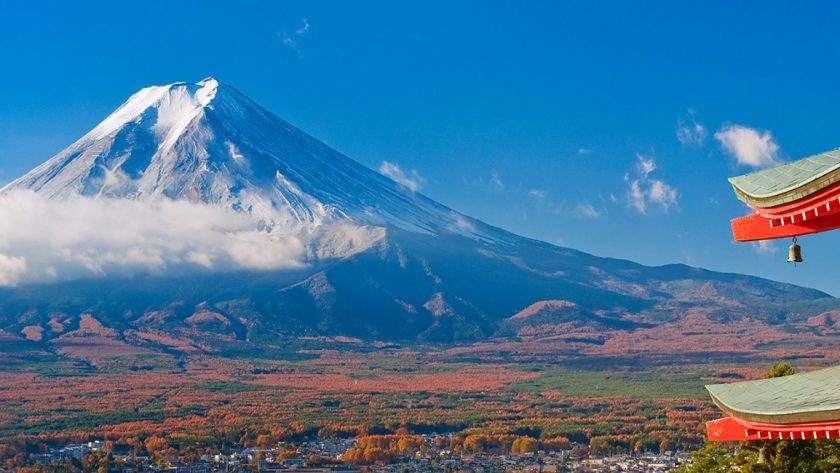Although I’m no stranger to oru naitas – Japanese all nighters, in which clubbers stay out past the last train of the evening and catch the first train of morning home – my sweat and breathlessness on a certain Japanese July night last year weren’t from dancing for hours. Instead, I’d stayed up all night in the most literal sense, as I climbed Japan’s Mt. Fuji. Night might not seem the ideal time for mountain climbing, but I wasn’t alone. Moving constellations of flashlights dotted the slopes, signs of the progressing hordes of climbers that night. We shared the same goal, the sought-after ideal of goraiko, or the witnessing of sunrise from the apex of Fuji.
The spirituality of goraiko ties into the mountain’s history in Japanese mythology. At one time, Japanese revered the mountain itself as a goddess, which meant that watching sunrise from Fuji’s apex – now a matter of national pride – was then a spiritual endeavor. Only men were permitted to climb its slopes; female climbers would make the goddess jealous, according to folk wisdom. That changed in the 19th century, though, and these days almost half of Fuji’s climbers are women – including me.
Late night buses out of Tokyo arrive at the mountain anytime between nine and ten p.m., so that those seeking goraiko can spend the next six or seven hours climbing. Travel agencies target different tourist strata by staggering bus schedules. Slow climbers start in the afternoon or early evening, usually ascending from waystation five, roughly the halfway point. It’s the most popular departure site for climbers tackling Fuji. Those seeking more of a challenge begin from lower stations, sometimes setting out as early as noon from the first station at the mountain’s base. For those who prefer to climb in daylight, the seventh and eighth stations have sleeping spaces available so hikers can tuck in for the night, and wake in the grey pre-dawn for a final push to the peak.
I got off the bus by myself at the fifth station at about ten p.m.; my friends were all busy that weekend, but I’d decided not to let that deter me from my goal. The trail initially seemed to be only a version of an unpaved country road. The trees rose up against the sky, where more stars were visible than in the Tokyo suburb where I taught junior high school English. The path got steeper abruptly, hairpin turns slashing their way up the volcano. The path was made up of packed earth covered in shallow layers of pebbles, interrupted occasionally with near-vertical stretches best climbed with the help of one’s hands. My breath came harder, and I stopped occasionally. I didn’t notice the gradual sloping of the vegetation and the increasing barrenness of the mountain – the view of Tokyo to the north was too distracting, the leviathan city stretching out serpents of lights and trains and roadways across the horizon.
By four a.m., I was freezing, but near the summit of the 12,387-foot mountain. I’d been climbing for six hours, ascending mechanically; my shoulders ached from reaching for handholds on steep scrambling sections, only just climbable without special equipment. But it was only twenty minutes until sunrise, and I was determined to make the intensely physical night hours pay off by catching dawn at the dormant volcano’s summit.
The line of people snaking before and behind me shared my sentiment, packing the last fifty meters of rock-hewn trail almost as densely as a rush hour subway train in Tokyo. July and August are the official climbing season for the affectionately named Fuji-san, when waystation huts are open and the weather is typically most cooperative. Though climbing is possible with equipment during the rest of the year, most of Fuji’s 300,000 annual climbers descend during the humid summer, escaping into the thin, frigid alpine air to savor the mountain that’s a Japanese symbol of pride.
I arrived at the peak with just enough time to settle in near the low stone walls that separate climbers from a bad, bumpy end; no time to get bored, which would have been easy at the peak. The summit lacks natural scenery, the flatness stark without more mountain rearing up behind it. In place of trees were booths and stalls selling mass-manufactured, overpriced souvenirs, postcards and key chains that would only clutter up my pack, already full with power bar wrappers, batteries, and water bottles. The more gung ho climbers stood in line, waiting to pay for the final stamp on their walking sticks, toted from the base and branded at each station – for a fee, of course.
The sun rose in a nearly cloudless sky over the stretches of green to the mountain’s east. The creeping sunrise illuminated Japan in a silent spread of light, beautiful, meditative -and sadly overwhelmed by the more persistent cold. Along with the gathered multitudes, I snapped my last exposure on my disposable camera before stumbling off, weary and shivering, to a refreshment hut. I ordered hot tea to warm my hands and throat. The air at Fuji-san’s summit can be as much as 400F colder than the air at sea-level; the warming effect of the aerobic climb only goes so far, and travelers at the top are inevitably swathed in layers of sweaters, jackets, gloves and scarves. My hooded red sweatshirt I’d put on a couple hours ago felt inadequate, and I huddled over my tea.
I departed soon after finishing my drink, picking my way through eating, drinking and catnapping tourists, and headed for the downward path. Having separate paths for each direction helps relieve tourist congestion. The return journey cuts through volcanic rock and piles of ash that stir with any movement. The drifting dust made me a ghost in grey and red, sliding down a sunlit moonscape. There was little purchase along the way down. Small rock slides sent hikers sliding several meters at a time, and soft-spoken queries from fellow climbers of “Daijobu?” – Are you ok? – floated in the crystalline cold of the air.
By the time I dropped below the tree line, I’d already been sweating for well over an hour, my fellow climbers and I slowly shedding our layered T-shirts, sweatshirts and jackets as we descended into a typical, tropical Japanese summer.
Little more than three hours later, I was half asleep in a restaurant at the fifth station waiting for the bus back to Tokyo . I was exhausted but exultant, grinning over green tea and toast. A Japanese proverb has it that it’s a wise person who climbs Fuji once, but a fool who climbs the mountain twice. Goraiko achieved, I finished my tea and slowly boarded my bus home.
Getting there: From Tokyo’s Shinjuku station a bus to the fifth station runs from the Yasuda Seimei 2nd Building, at the West Exit [JY2600]. Reservations for the 2.5hr. ride are required from Fuji Kyoku (tel 03-3374-2221). Alternatively, buses from the same spot in Shinjuku or from Hamamatsucho World Trade Center go to Lake Kawaguchi (Kawaguchiko) [JY1700]. For reservations, call Keio Teito (tel 03-5376-2222). Another bus from Kawaguchiko travels to the fifth station in 45 minutes [JY1700]. For those who prefer rail travel, the Chuo line from Shinjuku station goes directly to Kawaguchiko; a local train goes to Otsuki station, where a transfer onto the Fuji Kyuko line will get you to the bus station at Kawaguchiko [JY2500].



